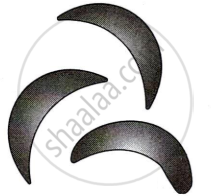Advertisements
Advertisements
प्रश्न
Why is pedigree analysis done in the study of human genetics? State the conclusions that can be drawn from it.
उत्तर
Pedigree analysis is done in the study of human genetics as
(i) It helps the genetic counsellors to guide the couples about the possibility of having children with genetic defects such as haemophilia.
(ii) It indicates that Mendel’s principles are also applicable to human genetics with some modifications found out later such as quantitative inheritance, sex-linked characters and other linkages.
Pedigree analysis is the study of the pedigree for the transmission of particular traits and finding the possibility of the absence or presence of that trait in the homozygous or heterozygous state in a particular individual.
संबंधित प्रश्न
Mention any two autosomal genetic disorders with their symptoms.
Identify I and II in the given diagram of chromosome.

Match the Column-I with Column-II and choose the CORRECT answer
| Column-I | Column-II | ||
| P. | Klinefelter syndrome | i. | Mutation in autosomal gene |
| Q. | Thalassaemia | ii. | Mutation sex chromosome linked gene |
| R. | Down syndrome | iii. | Trisomy of autosome |
| S. | Colour blindness | iv. | Trisomy of sex chromosome |
Identify the disease caused by an autosomal primary non-disjunction.
Choose the correct option which appropriately classifies the following disorders into Mendelian and chromosomal disorders:
Colour blindness, Down syndrome, Sickle cell anaemia, Turner syndrome, Thalassemia, Haemophilia, Phenylketonuria, Klinefelter syndrome.
In sickle cell anaemia glutamic acid is replaced by valine. Which one of the following triplets codes for valine?
Select the disease which is caused by recessive autosomal genes when present in homozygous conditions.
Which of the folowing is a correct match?
Describe Turner's syndrome.
Jacob is genetically a carrier of the disorder that affects the shape of the RBCs, as shown in the diagram below. His son James suffers from the same disorder.

- Give the biochemical reason for the disorder that changes the shape of the RBCs, as shown above.
- Draw a Punnett square to show the genotype of the mother of James.
- Name and define the type of 'point mutation' responsible for this disorder.
